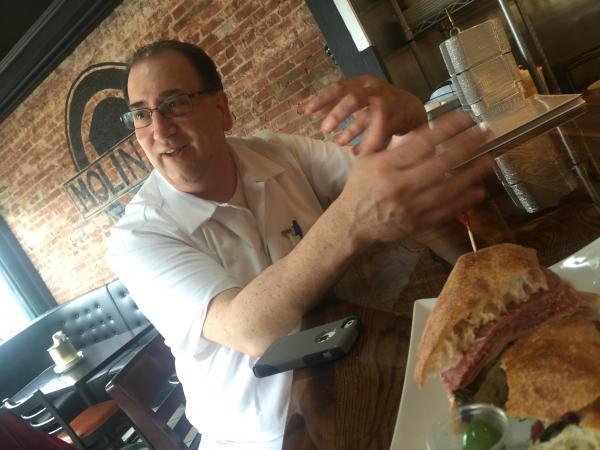July 21, 2016

Jeff Cincotta, the chef/owner of Molinari’s restaurant on Adams Street, is passionate about the Italian cuisine he creates. The eatery is named for his grandmother. Bill Forry photo
Squinting out the window onto the sidewalks of Adams Corner through thin, rectangular spectacles dangling from tip of his nose, Jeff Cincotta surveys his domain. “You never find the best food in the middle of the city,” he says, nudging the bridge of his glasses back to their temporary home between the eyeballs. “In New York, in Boston, it’s the side streets, the neighborhoods – that’s where all the gems are.”
Cincotta, a Boston native and the chef-owner of Molinari’s, an Italian eatery that served its first plate of pasta last month, has been hunting for a place like 789 Adams St. for years.
The surrounding side streets are all residential, and Cincotta is doing backflips to make Molinari’s a go-to in the neighborhood for all things down-home Italian, using the rollicking blaze in a brick oven imported from California as his not-so-secret weapon.
“At night, people walking by on the street will see the flames through the windows,” he says, “and they’ll wonder, ‘What’s going on in there?’ We’re the only place in Dorchester that uses a brick oven.”
That oven, with wood-fired heat convecting at a constant clip of around 735 degrees, is churning out pies and meatballs and salmon and any assortment of options from an ever-expanding menu as the Molinari’s team breaks in its new digs, which can seat roughly 30 customers.
Cincotta has opted for an open kitchen format with a clear view of the stove and an island counter, each plate’s last stop as cooks assemble dishes and wipe away with a towel any errant flecks of sauce that may have splattered onto unwelcoming spots of the final presentation.
On busy nights, patrons eating at the bar –Molinari’s hopes to obtain its liquor license by autumn – get a free look-in on one of the more entertaining nightly shows Dorchester has to offer.
“A lot of people like to cook, they like seeing what’s going on in the kitchen,” Cincotta says. “Really, I credit the boom in the American restaurant industry over the past 15 years to Bobby Flay and Emeril Lagasse, those guys on the Food Network. They let everyone into their kitchen, and it fired people up about food.”
Molinari’s, named after Cincotta’s grandmother, who grew up in a small village 45 minutes west of Rome, is inspiring that same passion. In its first month, the eatery blew away Cincotta’s expectations, doubling his revenue target for the first 30 days.
His explanation? “People want quality food,” he says, in a staccato rhythm, gently banging his left fist on the waxed, wooden bar in step with each word.
There are no shortcuts, the way Cincotta sees it. Molinari’s grills cuts of steak to order for those who select La Bisteca, a sandwich fast becoming a favorite among the swelling crop of regulars. The cooks slice and squeeze their own lemons and carve and pound by hand the breast for their chicken parm sandwich, crisping it in a pan of olive oil instead of unceremoniously dumping the cut into a basin of grease at the bottom of a deep fryer.
The star of our meal is the arancini appetizer: bronzed, breaded ping-pong balls of short-grain arborio rice and prosciutto held together by a gooey mozzarella glue. A paper-thin layer of panko crumbs provides a flawless initial crunch, and a ladle of Molinari’s rich pesto-marinara sauce is an apt condiment.
The star of most meals, though, is the pizza.
Cooking is all about the eternal pursuit of an unattainable perfection, Cincotta says, but with that pizza dough, he may have found pi’s last decimal.
“It’s a formula,” he declares from his perch on a chair at the bar, flipping to a laminated page in the middle of an unassuming, white three-ring binder where he stashes his savory secrets. With other dishes, there are variables you can’t always account for: ripeness of the tomatoes, exact heat of the skillet, thickness of the cut.
“With the dough, though, it’s the same basic ingredients every time – water, yeast, flour, salt. And I’ve been working on this recipe for 10 years.”
Cincotta is hustling to make Molinari’s the neighborhood’s go-to spot. A few weeks back, a couple entered with their five kids at 9:57 p.m. Molinari’s closes at 10. Cincotta scanned the restaurant and saw two more tables of six still working on their dinners. “I look back over my shoulder at my staff,” he says, fingering his stubborn specs, “and they give me this look: ‘Keep ’em here. We’ll take care of ’em.’”
Villages:
Topics:


